Week beginning 5 February 2018
- RBA on hold, unlikely to signal material changes in thinking but could reinstate AUD warning.
- RBA: policy decision, Statement on Monetary Policy, RBA Governor Lowe speaking.
- Australia: retail sales Dec & Q4, trade balance, housing finance.
- NZ: RBNZ Monetary Policy Statement, labour force survey, labour cost index.
- UK: BoE policy decision.
- US: ISM non-manufacturing, and various Fed speakers.
- Key economic & financial forecasts.
Information contained in this report was current as at 2 February 2018.
RBA on hold, unlikely to signal material changes in thinking but could reinstate AUD warning
The Reserve Bank Board holds its first meeting for 2018 next week on February 6. We expect policy to remain unchanged.
The Bank often uses its first meeting of the year to re-frame the policy discussion with an overhaul of the wording in the Governor’s statement accompanying the decision and the Statement on Monetary Policy (SoMP) released the following Friday providing an opportunity to present revised forecasts and a fuller elaboration of its views.
We do not expect to see a major shift this time around. The Bank will acknowledge the more positive tone from abroad and from some of the domestic data. It may also alter its commentary, particularly around the AUD. However, its central view from late last year – that "continuing spare capacity in the economy and the subdued outlook for inflation mean that there is not a strong case for a near-term adjustment in monetary policy" – is likely to remain in place.
There have been several notable developments since the RBA Board’s December meeting:
- The global backdrop has again improved with robust momentum, tax cuts and supportive financial conditions in the US, China’s growth coming in above expectations and the IMF upgrading its global outlook for 2018 and 2019. The Fed is now widely expected to raise rates 75bps this year but markets have taken the shifting view in their stride.
- Locally, the Q3 national accounts, released the day after the last Board meeting, showed growth still tracking below potential and a weak picture around the consumer (spending flat, savings up and incomes mixed at best).
- Labour markets have continued to show strong momentum, with 98k jobs added over Nov-Dec and a clearer lift coming through in the mining states. There is still considerable slack in the market though – the unemployment rate holding around 5.5%, well above the 5% mark regarded as ‘full employment’, and broader measures showing even more spare capacity once underemployment is included.
- Confidence has lifted, with consumer sentiment recovering from its Q3 ‘hole’ and business surveys remaining buoyant. While a welcome improvement for the RBA, the lift in consumer sentiment is still not quite a break-out with the detail suggesting ongoing spending restraint. We expect next week’s retail report – due the morning of the RBA meeting – to confirm a recovery Q4 but with sales growth still subdued.
- Inflation finished 2017 a touch softer than expected, the CPI rising 0.6% in Q4 to be up 1.9%yr. Core inflation also came in at 1.9%yr but tracked a 1.6% annual pace over the second half of the year.
- The AUD/USD cross has risen 5.5% since the RBA’s December meeting to be back above the levels prevailing at the Board’s August meeting. The move is mainly about the USD, with the AUD showing a much more muted 2.3% gain in TWI terms.
On balance, these shifts are unlikely to have a material impact on the RBA’s medium term views. We expect the Bank to stick with the real GDP growth profile from its November SoMP: 2.5% for end 2017, lifting to and holding at 3.25% for end 2018 and end 2019. While some of the detail was soft, the September quarter GDP outcome (0.6%qtr for real GDP) was in line with the RBA’s expectations as implied by the 2017 growth forecast. In addition, economic growth over the first half of 2017 was revised up, to 1.4% from 1.2%.
More generally, a slightly softer picture around consumer spending following the September quarter national accounts is balanced by a more supportive global backdrop, commodity price resilience, jobs growth, and upbeat private business surveys.
The technical assumptions underpinning the RBA’s forecasts are unlikely to prompt shifts either. While the currency is higher against the US dollar, 80¢ currently vs 77¢ in the November SoMP, it is unchanged on a TWI basis, at 65 – and hence unlikely to be a reason to revise growth forecasts.
That said, the currency move is likely to see a shift in commentary. The Governor’s statement following the December Board meeting included wording changes that indicated the Bank was less concerned about the AUD, noting simply that "the Australian dollar remains within the range that it has been in over the past few years". It may choose to reinstate the wording that had been in place previously: "An appreciating exchange rate would be expected to result in a slower pick-up in economic activity and inflation than currently forecast."
On inflation, the Bank’s broad view that it will remain around or slightly below the 2-3% target band throughout 2018 and 2019 is unlikely to change. The RBA may consider nudging its near term forecasts for underlying inflation up slightly. The November SoMP had underlying inflation at 1.75% in December 2017 and holding at this pace throughout 2018. This looked overly weak at the time (our forecasts were for underlying inflation to hold at 2%yr) and with the December 20107 quarter coming in at 1.9%yr to anticipate a near term slight step down now looks a little awkward. However, the Bank would emphasise any shift as being a minor rounding ‘tweak’ rather than a material change in view.
Aside from acknowledging the mostly positive developments since its December meeting, and restating its ‘on hold’ policy stance, we expect the Governor’s decision statement, the SoMP commentary, as well as the speech by the Governor on Thursday to again highlight the main areas of concern for policy. These were set out clearly in Governor Lowe’s ABE speech in late November, with the focus on three key issues:
- how the ‘cross-cutting themes’ of rising businesses confidence and a subdued consumer resolve;
- the degree to which an improving labour market will translate into a pick-up in wage growth and inflation; and
- how high and rising household debt levels will affect the stability of the economy over the medium term.
These questions will take longer to resolve, with the main focus on quarterly wage inflation and national accounts updates.
Most of the Bank’s concerns centre on the Australian consumer. The Governor’s speech also noted that "for a number of years consumption growth has been weaker than we had originally forecast" and that "it has not exceeded 3 per cent for quite a few years". With the RBA’s upbeat growth forecasts relying on a lift in consumption to 3%, the Governor is rightly nervous about prospects for the consumer.
We continue to see a more challenging year ahead for the Australian consumer and another sub-par year for wider economic growth – a mix that means policy will remain firmly on hold. Westpac expects rates to remain unchanged throughout 2018 and 2019.
The week that was
Inflation and housing have been the focus for Australia this week. Offshore, President Trump and the FOMC stole the limelight, but a timely update on Chinese growth was also delivered.
The December quarter CPI report for Australia carried a high degree of importance given the market was close to fully pricing a RBA rate hike before year end. An upside surprise on core inflation would have cemented this expectation, but in the event, both core and headline inflation disappointed. The headline CPI rose 0.6% in Q4, with half of the gain coming from higher tobacco prices and the remainder fuel. There was little momentum elsewhere, the other CPI components netting out against each other. Stripping out outsized movements, core inflation rose 0.4% for a second consecutive quarter, leaving annualised core inflation at just 1.6%yr. Looking ahead, the disinflationary pulse from competition in the consumer sector and housing are expected to persist, and the recent rise in the Australian dollar will also act as a headwind. The net effect is that core inflation will remain at or below the bottom of the RBA’s target band of 2.0%yr through 2018 (and 2019). This will see market expectations for a rate hike pushed further out from early 2019 currently. We remain of the view that the RBA will be on hold through 2018 and 2019.
Like inflation, the housing market is also unlikely to justify tighter policy anytime soon. The latest price data from CoreLogic suggests home prices fell a further 0.5% in January to be down 1.0% since October (but still up 3.2% over the year). There remains a material disparity between price growth in Sydney and Melbourne, respectively 1.3%yr and 8.0%yr in January (from 7.7%yr and 11.0%yr three months ago). Elsewhere, annual growth of near 2.0%yr is occurring in Adelaide and Brisbane, while price declines in Perth are tracking around 2.5%yr. Whereas the price deceleration was initially concentrated in houses, it is now spreading to units as supply ramps up. An unfolding slowdown in housing credit and caution amongst households towards the sector indicate price growth is unlikely to accelerate meaningfully in 2018.
While projects nearing completion will continue to add to supply, a renewed downtrend in dwelling approvals suggests that the flow of new supply will taper. Having surged 13% in November, total approvals slumped 20% in December to be 5.5% lower over the year. This monthly volatility was driven by high-rise approvals, particularly in Victoria. Site purchase data suggests this high-rise downtrend has further to run. Non high-rise approvals are also down 3.5%yr on a trend basis. Looking through recent volatility, our expectation that dwelling investment will subtract from growth in 2018 and 2019 has a firm foundation.
Moving offshore, the US was the market’s focus this week as debate over the stance of policy and US dollar weakness raged on. In his first State of the Union address, President Trump called for greater investment in the US economy (a mooted $1.5trn infrastructure spending plan, primarily funded by state and local governments and the private sector), but this was paired with further protectionist and geopolitical rhetoric. The net effect for the US dollar and interest rates was negligible. Markets are likely to leave both issues to the side until concrete detail is provided. In the meantime, anxiety over another potential government shutdown next week and the debt ceiling debate will continue to weigh on the currency. On rates however, the FOMC’s more confident tone at their January meeting was enough to cement expectations of a March rate hike.
Further out, the market is close to pricing in our own view, that a further two hikes will be delivered by September to take the mid-point of the fed funds range to 2.125%. Come the December quarter, the Committee will have to be more aware of the potential consequences of balance sheet reduction on financial conditions – in addition to the effect of the three rate hikes. The main consequence for Australia is likely to be that our currency will depreciate from the current level around USD0.80 to USD0.72 at end-2018. However, a repricing of rate expectations outside the US based on the FOMC’s progress and renewed financial market volatility are risks to watch out for.
Finally, while it received little attention, China’s official PMI update provided an important insight into the economy’s momentum as 2018 began. On the whole, activity in the manufacturing and services sectors remains robust. But there is clear evidence that it is slowing, most notably due to weaker external demand (i.e. exports). A much reduced contribution from net exports will be a key reason why 2018 growth will slow to around 6.2% from 6.9% in 2017; weaker growth in investment will also be behind this softening. In contrast, consumer demand should hold up, unless we see a further deterioration in employment conditions.
New Zealand: week ahead & data wrap
The past week has been fairly quiet, but next week will be huge with a labour market update from Stats NZ, a dairy auction, and a Reserve Bank Monetary Policy Statement on the calendar.
The economy lost momentum over 2017, with GDP growth slowing and business confidence tanking. But this growth slowdown has not yet affected the labour market. The unemployment rate has fallen steadily over the past year. Job advertisements, benefit numbers and business opinion surveys have all continued to improve steadily, and firms are now reporting the greatest difficulty finding labour since 2005. Given these indicators, we expect next week’s Household Labour Force survey to report that unemployment fell from 4.6% to 4.5% in December 2017.
Although the labour market is unambiguously firm, we expect data volatility will lead to a weak – looking employment number this quarter. In September, employment rose a whopping 2.2%, and the labour force participation rate experienced a matching jump. This was incongruous with other data and may have partly reflected sampling error. We’ve assumed some pullback in the participation rate, and a relatively small 0.2% rise in employment for the December quarter.
After several years of falling unemployment, one could be forgiven for wondering whether wage growth is about to accelerate. There are no signs that wage growth did accelerate in the December quarter – we expect the Labour Cost Index will register another 0.4% quarterly rise in private sector salaries and wages. What happens to wage growth in 2018 is a more open question, but in our view it will accelerate only slightly. We expect the economy to continue losing momentum, which could stall or reverse the trend of falling unemployment, and forestall any significant market pressure for rising wages. Wage increases are more likely to come about via government policies that tip the balance of power more towards workers, such as changes to employment laws, higher minimum wages and a shift towards collective agreements.
The Reserve Bank will watch the labour data with interest, given the Government’s plans to include employment as well as price stability in the Reserve Bank’s monetary policy goals. This probably wouldn’t have made much difference to the RBNZ’s actions in years past – employment and inflation both argued for keeping interest rates low. But with the unemployment rate now around neutral and inflation below target, there is more scope for conflict between the two mandates. That said, the RBNZ won’t be able to take this quarter’s labour data into account for its Monetary Policy Statement, which is due the following day.
We are expecting very much a steady – as – she – goes MPS. We anticipate no material change from the RBNZ’s previous OCR forecasts, and no change to the policy guidance paragraph, which for a year now has remained more – or – less unchanged:
"Monetary policy will remain accommodative for a considerable period. Numerous uncertainties remain and policy may need to adjust accordingly".
The RBNZ’s press release, and the detail of the Monetary Policy Statement, will no doubt allude to the key developments and surprises since November, of which we count five:
Inflation was substantially lower than forecast in December 2017. The exchange rate has risen unexpectedly. The RBNZ may return to its previous rhetoric that "a lower exchange rate is needed," which could cause the exchange rate to fall on the day.
The housing market has a new lease of life, which will reinforce the RBNZ’s apprehension about keeping interest rates too low for too long.
Revisions to historical GDP data from Stats NZ have shown that the economy grew more over 2015 and 2016 than previously estimated. This implies that the output gap is higher and the economy is closer to experiencing inflation pressure than previously thought.
Global economic data has been strong and global equity prices have risen rapidly. This will rate a mention from the RBNZ, but probably won’t affect their overall assessment much.
Some of these developments are positive for inflation and others are negative, but we judge the overall balance to be roughly neutral from the RBNZ’s perspective.
We have long argued that the RBNZ’s forecasts of GDP growth, house prices and inflation are too high. The Government may be planning something of a fiscal boost to the economy, but it also plans a range of measures specifically designed to cool the housing market and slow net migration. We think these measures will have a more marked effect on house prices than the RBNZ anticipates, and a slower housing market would, in turn, impact GDP growth. Moreover, the recent sharp decline in business confidence portends weaker GDP growth in the short run. Hence our GDP forecast is markedly lower than the RBNZ’s previously published forecasts. Slower GDP growth naturally leads us to fret less about inflation accelerating. But there is another leg to our lower inflation view. A range of factors, including new technology, have also been supressing inflation for years, and we expect this trend will continue – we doubt that inflation would accelerate in the fashion the RBNZ expects, even if GDP growth did accelerate.
Our low – inflation view leads us to expect that any OCR hike will be delayed until late – 2019 (and we have even occasionally warned that there is still a chance of further OCR cuts). Our view stands in stark contrast to financial markets, where pricing is consistent with the OCR rising in late – 2018 or early – 2019. We doubt that market pricing will shift following the Reserve Bank’s statement, but we do expect market pricing for OCR hikes to drift later over the course of this year.
Data Previews
Aus Dec retail trade
Feb 6, Last: 1.2%, WBC f/c: – 0.3%
Mkt f/c: -0.2%, Range: -1.2% to 0.4%
- Retail sales surged 1.2% in Nov, a surprisingly strong result that was the biggest monthly gain since Feb 2013. The ABS cited the launch of Apple’s iPhone X and the increased popularity of ‘Black Friday’ sales as major factors with electrical and electronic goods retailers recording a 9.3%mth surge and sales for ‘other retail n.e.c’, which includes non store retailers, up 3.9%mth. Sales excluding these two sub-categories were up a milder 0.4%mth.
- While there were clearly extenuating circumstances in Nov, ‘underlying’ sales look to have recovered somewhat from the weakness in Q3 with consumer sentiment improving steadily through Oct-Jan. That said, family finances are still under pressure with spending intentions subdued and private sector business surveys indicating retailers continued to struggle with soft conditions in Dec. On balance we expect sales to retrace 0.3% in Dec as one-off factors drop out but leaving a modest gain over the last 3mths.
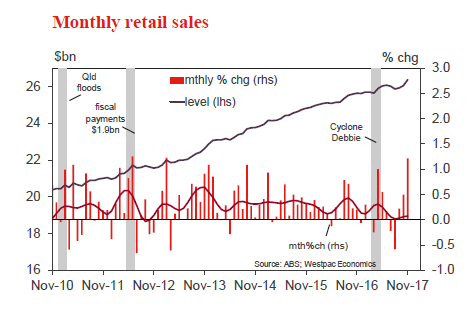
Aus Q4 real retail sales
Feb 6, Last: 0.1%, WBC f/c: 0.6%
Mkt f/c: 1.0%, Range: -1.4% to 1.2%
- Retail volumes stalled in Q3, rising just 0.1% vs a 1.5% gain in Q2, a weather-affected 0.2% gain in Q1 and a 0.9% gain in Q4. The quarterly profile is choppy but has been tracking a weak underlying trend.
- The Q4 update will show a significant improvement. Even with a pull back in the Dec month, nominal sales are on track to be up over 1% for the quarter. The Q4 CPI detail showed mixed results for retail prices. Intense competition saw increased discounting in categories such as household contents and clothing. However, food, which makes up over 40% of retail sales, posted a stronger than expected 1% rise in the quarter vs a 0.9% fall in Q3. The mix suggests about half of the gain in nominal sales in Q4 is due to prices. We expect real retail sales to be up 0.6% for the quarter. With price moves mixed across categories, there is some upside risk to the quarter particularly if spending patterns have responded to relative price shifts.
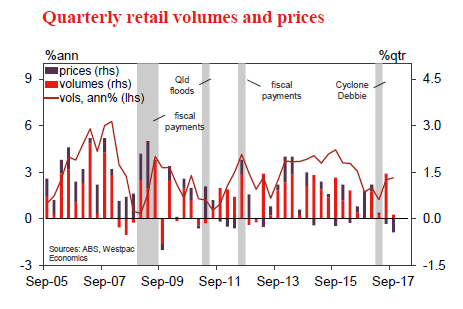
Aus Dec trade balance, AUDbn
Feb 6, Last: – 0.6, WBC f/c: 0.7
Mkt f/c: 0.2, Range: -0.9 to 0.7
- Australia’s trade balance slipped into deficit in October and November on a dip in exports.
- For December, we anticipate a return to surplus, a forecast $0.7bn, a $1.3bn turnaround on November, led by a rebound in exports.
- Export earnings in December increased by a forecast 4.5%, $1.4bn, centred on iron ore, coal and LNG, reflecting a rebound in volumes and higher prices.
- Imports are expected to edge higher, 0.4% (+$0.1bn), on rising volumes. Prices are likely little changed, with the currency consolidating in the month, so too global energy prices.
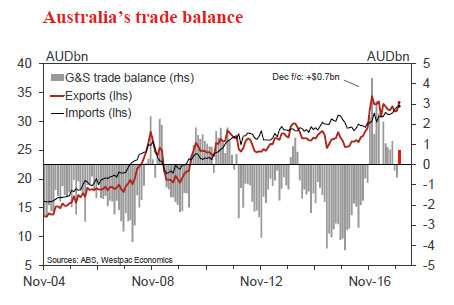
Aus RBA policy decision
Feb 6, Last: 1.50%, WBC f/c: 1.50%
Mkt f/c: 1.50%, Range: 1.50% to 1.50%
- The RBA left interest rates unchanged throughout calendar 2017, Governor Lowe noting in his final speech of the year that: "the continuing spare capacity in the economy and the subdued outlook for inflation mean that there is not a strong case for a near-term adjustment in monetary policy".
- We expect the RBA to leave rates unchanged at its Feb meeting. Developments over the summer hiatus have been mixed with the Q3 national accounts disappointing but more positive news around global conditions, labour markets and confidence. Inflation remains subdued, with latest figures showing core inflation running at a 1.6% annual pace over the second half of 2017. There is also no new information around the Bank’s key areas of uncertainty – the impact of lacklustre consumer demand; the extent to which weak labour income growth continues; and the risks around household debt. We expect consumer weakness to persist in 2018, leading the RBA to again leave rates on hold all year.
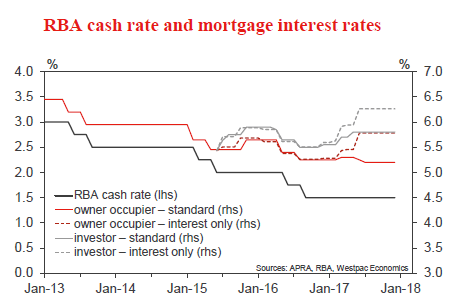
Aus Dec housing finance (no.)
Feb 9, Last: 2.1%, WBC f/c: – 1.5%
Mkt f/c: -1.0%, Range: -1.9% to 0.5%
- Finance approvals have held up much better than expected through 2017, the most recent figures showing a 2.1% rise in the number of new owner occupier loans in Nov and a 1.5% rise in the value of investor loans. The latter are down – 8.3%yr but the total value of finance approvals is up 4%yr despite auction activity, turnover and price growth all showing a material slowdown in the major eastern markets.
- Industry figures point to a softer month for owner occupier approvals some – Dec is expected to show a 1.5% decline. However, the general picture is still better than might have been expected given macro-prudential measures and a similar sized slowdown in 2015, which saw the total value of loans fall 13% peak to trough. It may indicate that weaker foreign buyer demand had a bigger hand in the 2017 slowdown.
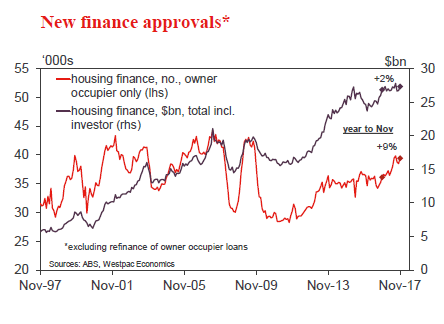
NZ Q4 Household Labour Force Survey
Feb 7, Employment last: 2.2%, WBC f/c: 0.2%, Mkt f/c: 0.3%
Unemployment last: 4.6%, WBC f/c: 4.5%, Mkt f/c: 4.7%
- We expect a small decline in the unemployment rate from 4.6% to 4.5%, which would be a new nine – year low. Job advertisements, benefit numbers and business opinion surveys all point to steady rather than rapid improvement in the jobs market over the quarter.
- Both employment and labour force participation have been very volatile recently. We expect some payback from their sharp gains in the September quarter, without affecting the broader picture of a stronger jobs market.
- The employment figures will undoubtedly come under more scrutiny this year, with diminishing slack in the labour market and a new Government focused on tipping the balance of power more towards workers.

NZ Q4 Labour Cost Index
Feb 7, Private sector Last: 0.7%, WBC f/c: 0.4%, Mkt f/c: 0.5%
- We expect a 0.4% rise in the private sector Labour Cost Index for the December quarter. Wage growth has been running at the same quarterly pace for the last couple of years, aside from the 0.7% rise last quarter, which included the equal pay settlement for aged and disability care workers.
- We have no evidence to suggest there was a stirring of wage pressures in the December quarter. Indeed, the latest Westpac – McDermott Miller employment confidence survey found fewer workers reporting a rise in earnings over the last year.
- The Quarterly Employment Survey (QES) suggests a stronger rate of growth in hourly earnings. However, this measure is affected by changes in the composition of jobs.
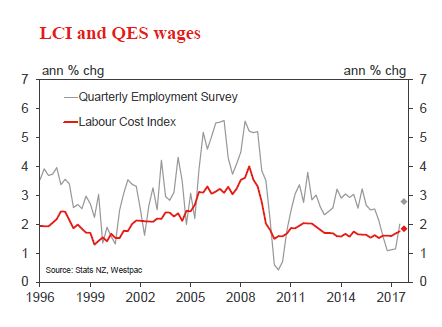
NZ RBNZ Monetary Policy Statement
Feb 8, Last: 1.75%, Market: 1.75%, Westpac 1.75%
- We expect the RBNZ to continue with its firmly neutral OCR outlook and repeat its long – held guidance that "Monetary policy will remain accommodative for a considerable period".
- Recent developments have been roughly neutral, with low inflation and the high exchange rate counterbalanced by a resurgent housing market and upwardly revised GDP.
- Foreign exchange markets may react to any comment about the exchange rate being too high, but interest rate markets are unlikely to be perturbed by a steady – as – she – goes MPS.
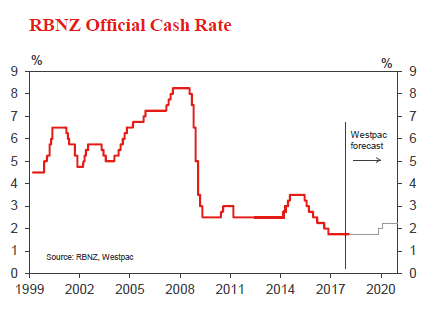
UK Bank of England Bank Rate decision
Feb 8, Last: 0.5%, Mkt: 0.5%, WBC f/c: 0.5%
- Inflation is sitting at the top of the BOE’s target band and while growth remains sluggish, spare capacity has been eroded and there are positive signs in parts of the economy. Against this back drop, BOE Governor Carney recently noted that "we’ve moved into a more conventional area for monetary policy where the focus is increasingly on returning inflation sustainably to target over an appropriate horizon."
- We expect the BOE will keep the Bank Rate on hold at 0.5% at its February meeting. In addition, the BOE is expected to maintain the very gradual tightening bias it adopted late last year, when it noted that some modest interest rate increases were likely over the next few years. The Governor’s recent comments suggest some risk that the MPC strengthens its rhetoric around the rates outlook. However, given the lingering downside risks for activity stemming from Brexit, we continue to see the risk that any tightening comes later, rather than sooner.













